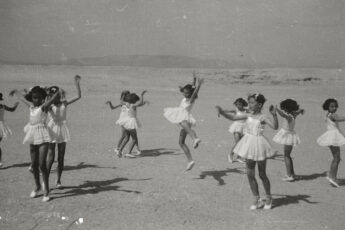On Houses and Homelands
Anna Dziapshipa’s Self-Portrait Along the Borderline (Avtoportreti zghvarze, 2023)
Vol. 140 (December 2023) by Zoe Aiano
Referencing the famous work by Frida Kahlo, Anna Dziapshipa’s feature documentary Self-Portrait Along the Borderline reflects on a life divided between states. However, while Kahlo’s painting depicts the politically established partition between the US and Mexico, Dziapshipa is concerned with the more contested border (or non-border) delimiting Georgia and Abkhazia. While Georgia lays claim to Abkhazia as part of its sovereign territory, a number of nations recognize its independence and access to the region remains restricted. The child of a mixed Georgian-Abkhazian family, Dziapshipa is fixated on the idea of revisiting her family home, denied to her since the war of 1992 and 1993. Accordingly, the film is structured not only around her personal quest to gain access to this vessel of her childhood memories, but also as a reflection on how it is to live torn between two conflicting identities.
The film consciously avoids any historical or ideological analysis of the war, instead providing the bare minimum of essential information to give space to the human experience of its fallout. The director traces her own family history back to her grandfather, a successful Abkhaz footballer, and as such an erstwhile symbol of cultural integration. It was this grandfather who built the house intended to serve as a gathering space for generations to come but which instead has become inaccessible and abandoned. Without idealizing the years of Soviet coexistence, Dziapshipa moves on to the shift that took place in her generation, the war generation, and the growing sense of otherness and taboo that emerged during her childhood.
The first part of the film is constructed largely from archival footage, seamlessly blending newsreels, historical documentary, and personal family footage, dissolving the separation between private and public imagery, and consequently individual and collective history. The vintage images of Abkhazia duly evoke the idealized nostalgia of a disputed coastal resort region, while the voice-over undermines this picture postcard idyll. At times this takes the form of political announcements refuting the existence of Abkhazia as an autonomous entity or stigmatizing the Abkhaz people as enemies of the state, all juxtaposed with serene images of athletes displaying their unity or groups of well-to-do friends enjoying a fun day at the sea. The most shocking of these is a speech directed at school children, indoctrinating them against the Abkhaz and actively encouraging them to ostracize them. For the majority of the duration, however, the commentary is provided by Dziapshipa herself, with poetic and poignant reflections delivered in an impassive, matter-of-fact manner.
The most creative use of archival materials is found in the recurring appearance of a nature documentary about spiders. The narration discusses arachnids’ migration patterns and their capacity for adapting to new environments, their webs not only providing housing but also serving as a weapon for hunting. It’s an interesting framework for discussing forced migration and the simultaneous fragility and resilience of concepts of home. What is even more interesting is the fact that the documentary itself was fabricated by Dziapshipa, drawing on a scientific book to create a script to put over old stock footage. Combined with the already ambiguous sources – and therefore equally ambiguous implications – of the other images used, this creates a sub-text that forces viewers to go beyond the surface meaning of the content they are presented with, questioning the intentions of those who originally created the images and reconsidering what those same images actually convey.
The second half shifts from the past back to the present day, with a concomitant change from the largely black and white archives to purpose shot footage in color. Having succeeded in gaining access to Abkhazia, the director looks around to compare the landscape in front of her with the images she’s been presented with up until that point. This paradise lost is shown as somehow stuck in time, a faded beauty duly shot with sepia-like orange hues. It isn’t depicted as war-torn or dilapidated, but there is a certain uncanniness to the atmosphere. This is particularly well captured in a scene of an opera singer accompanied by a pianist in an ageing theater, which has something of the unsettling beauty of a David Lynch film.
Ultimately, after a long struggle to find its exact geographic location, Dziapshipa manages to gain access to her house, which is as hauntingly abandoned as you would expect. Dusty and filled with cobwebs, it’s hard to picture it ever teeming with life as the epicenter of extended family gatherings. Only few traces remain that testify to any personal inhabitation of the space. The film ends somewhat abruptly, this mission having been fulfilled, and while it comes as something of a dramaturgical shock given the rhythmic flow of the rest of the narrative, it nevertheless feels fitting. After all, fragmented identities are not easily pieced back together through gestures, no matter how symbolic, and re-claimed spaces are not automatically revived. Abkhazia remains in limbo, as does this house.




Leave a Comment